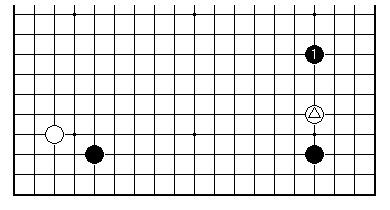

Ch'ung Am is the name of a well-known high school in Seoul. It is also the title of a research group of younger professionals who have done much to build up the reputation of Korean baduk as the home of the secret opening weapon. From its founding in 1988 around Yi Ch'ang-ho (Lee Chang-ho - see John Fairbairn's list of Korean names) it was supposed to be a covert operation in the international Go rivalry that was brewing. Innovation on the scale achieved couldn't be kept permanently under a bushel, and a recent three-volume work from the Korean Baduk Association publishes a thousand pages of detailed analyses. Astonishingly the group of contributors, said to be the third 'wave' of Ch'ung Am researchers, are all under sixteen years of age.

We'll look at Black's effort to play forcefully in the Anti-Chinese, when White plays the high approach (marked stone) in the right-hand corner. The two-point high pincer (aka the Magic Sword) shown as Black 1 is a natural choice, considering that it is backed up by a Black stone in the top right.
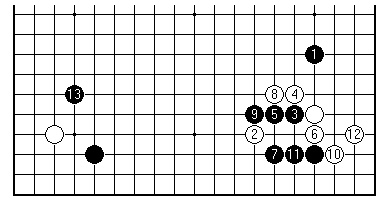
The Magic Sword has been the great beneficiary of developments in openings over the past two decades, while the standing of other complex corner sequences has fallen back. The professional way, however, is still to consider its merits case by case, in given overall contexts. In this setting the Magic Sword came to prominence in 1990 in some important games. In March of that year it was played by Cho Hun-hyeon against Seo Pong-su in the Wangwi title match in Korea, leading to this position.
The sequence in the right-hand corner is the mainline variation. White is settled, so the question is how Black can develop from there. The lower and right sides typically become miai in a rather loose sense: Black could do with a play in both areas. Black 13 is the most powerful available play.

In June of that year Kobayashi Koichi played the same way against Cho Chikun in game 3 of the Honinbo match. Cho played 12 in the corner in the sharper, more territorial way. This variation leaves moot the cutting point at 22 (if Black cuts there a ladder arises). White 12 as shown does more to undermine Black's group on the lower side. This goes some way to explaining the sequel. White ignores 13, which one is normally advised not to do, and reinforces on the right. Black plays in hope of developing on both sides, coming back to 23. White then attacked on the right, leading to a close game.
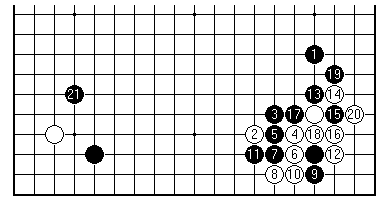
Then in July the Fujitsu international brought together Rin Kaiho and Kobayashi Koichi in the semi-final. Rin tried the influence-oriented play 3, an invention of Kajiwara Takeo 9 dan, Kobayashi's old preceptor from the Kitani dojo. Complexities arise as Black seeks the best way to sacrifice two stones in the corner, but the framework plan up to 21 is evident.
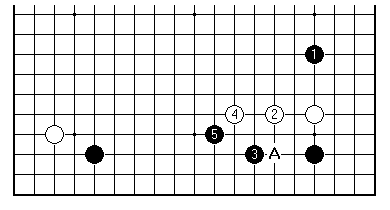
After that this pattern seemed to be put to one side, and one can ask why. Analysis of Yang Yilun (Whole Board Thinking in Joseki vol.2) suggests that White 2 here is to be preferred. Simply jumping out with 2 and 4 has advantages if White intends to attack on the right side next. It is also more respectful of Black's potential framework on the lower side, avoiding being cut simply in order to play one line deeper. There is a more subtle point: Black should choose 3 rather than A, in order to get up to the fourth line with 5 for balance. This however leaves weaknesses that White may exploit in later fighting. (The plays 2 to 5 occurred in the same Fujitsu event in the third place playoff Kobayashi-Cho Hun-hyeon, but in a game where Black had a 3-4 point top right.)
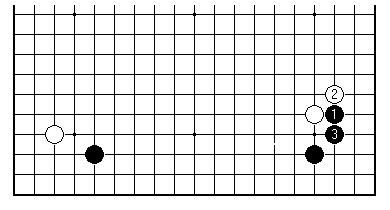
The orthodox inside contact play Black 1 here is back in fashion, anyway, being played by Chang Hao of China against Kudo Norio of Japan in the 1998 Tengen-Tianyuan international. This constitutes a victory of sorts for the Nihon Ki-in steady style.
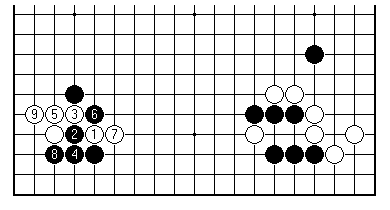
One would have to pour considerably more rain on the parade of a hungry young pro with a sharp position to analyse, to make it lose its savour. So, returning to the Wangwi game Cho-Seo that started it all, this was the continuation in the left-hand corner. We get a lesser-known version of the taisha (great slope): White must contest Black's framework plan, so 1 seems compulsory. Then 5 at 6 would simplify matters - but the requisite ladder is broken by Black's stone top right, so it's into the main tangle of variations. The taisha is called the 'joseki of 1000 lines', and there is really no need to brand that as hyperbole.
White 9 has the meaning that White will try to live quickly on the edge. The best way White can currently help 1 and 7, swimming in Black influence, is to reduce the impact of double-purpose plays near Black 6.
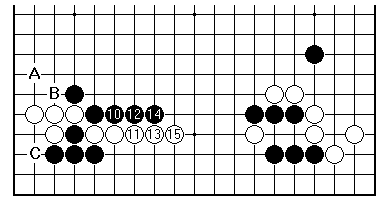
Pushing along with 10, 12, 14 is a typical Black option. Now A is the interesting Ch'ung Am concept, Black B is the actual game, with White surviving. Anyone can see that C is a key point for the eye shape of both, but here it is too slow for Black.
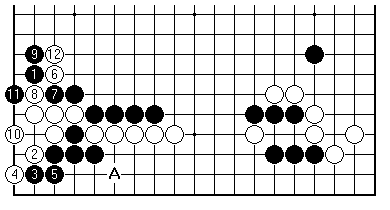
There is little choice once White is shut in. Up to 12 White doesn't have time to fight a capturing race with Black by playing at A. Prospects must be sought on the outside. This is a an ultra-hard case of what I called a 'skin fight' in Teach Yourself Go.
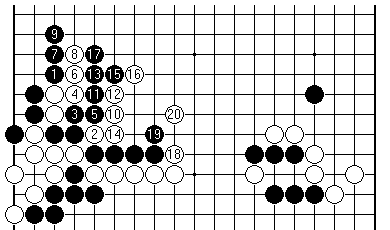
This is a typical variation. Black 1 and 9 are natural plays, but the position is radically unstable. Black 11 is a way to avoid being squeezed into bad shape (which would make White 18 ever more powerful); but ends in failure as White 20 nets the key stones. Backtracking, it seems that Black 9 is at fault.
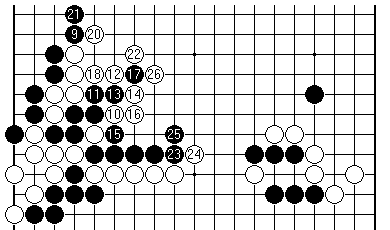
This is given as an alternate, tight-rope walking continuation (19 connects). The number of unresolved issues of life-and-death on the lower side is growing by the minute.
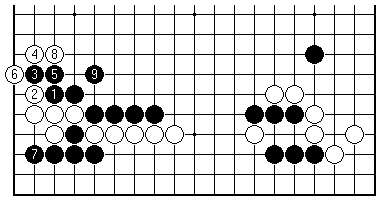
With that rather considerable burden to be borne in mind, the game continuation by Black might be thought to have compromised in the direction of practicality. With 1 and 3 Black gave White the option to sneak out with 4 and 6; by playing 3 before 1 Black would have forced White into cutting at 5 instead. Hindsight is of course a great leveller.
[01]
[02]
[03]
[04]
[05]
[06]
[07]
[08]
[09]
[10]
[11]
[12]
[13]
[14]
[15]
[16]
[17]
[18]
[19]
[20]
[21]
[22]
[23]
[24]
[25]
[26]
First published 18 January 2001 as On Your Side on MindZine,
Go Learning
© Charles Matthews 2000.